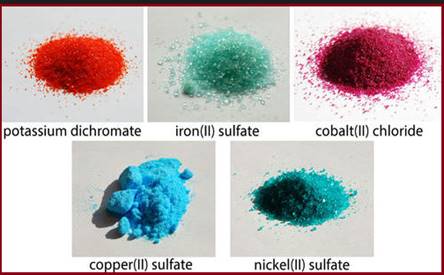
What characteristics of the
Interpretation:
The characteristics of transition elements that set them apart from main group elements have to be described.
Concept Introduction:
In the periodic classification of elements, elements are classified into s-block elements, p-block elements, d-block elements and f-block elements. The d-block elements (group
Answer to Problem 22.1QP
Following are the characteristics that make transition elements unique from main group elements -
- All of the transition elements are metals but all of the main group elements are not metals.
- Transition elements have higher melting points than main group elements.
- Transition elements exhibit more variable oxidation state in its compounds unlike main group elements.
- Transition elements form more colored compounds and paramagnetic compounds than main group elements do.
- Many of transition elements form complex compounds, also known as co-ordination compounds than main group elements do.
- Transition elements have higher densities than main group elements.
Explanation of Solution
Transition elements are metals. But main group elements are constituted of metals, non-metals and metalloids.
Due to higher density transition elements tend to exhibit higher melting point than main group elements. For example, Tungsten is a transition element and has melting point
Transition elements tend to form ions with various oxidation states whereas oxidation state of main group elements will not be more than two or three types. Transition elements exist in zero oxidation state too in its compounds unlike main group elements. For example, Manganese, a transition element has oxidation state of
Many of the compounds formed by transition elements are colored unlike the compounds of main group elements. For example, Cobalt (II) chloride is pink in color whereas Tin(II) chloride is colorless.

Figure 1
Many transition elements
Transition elements are far different and unique from main group elements in both physical and chemical properties.
Want to see more full solutions like this?
Chapter 22 Solutions
General Chemistry - Standalone book (MindTap Course List)
- Iron is the most abundant transition element in nature. Identify common chemical and physical properties of this element.arrow_forwardThe compound cisplatin, Pt(NH3)2Cl2, has been studied extensively as an antitumor agent. The reaction for the synthesis of cisplatin is: K2PtCl4(aq)+2NH3(aq)Pt(NH3)2Cl2(s)+2KCl(aq) Write the electron configuration for platinum ion in cisplatin. Most d8 transition metal ions exhibit square planar geometry. With this and the name in mind, draw the structure of cisplatin.arrow_forwardIdentify a cation of a first series transition metal that is isoelectronic with each of the following. (a) Fe3+ (b) Zn2+ (c) Fe2+ (d) Cr3+arrow_forward
- Give the symbol of the main-group metals in period 4 with the following number of unpaired electrons per atom. (Transition metals are not included.) (a) 0(b) 1(c) 2(d) 3arrow_forwardTi(NH3)63+ has a d-orbital electron transition at 399 nm. Find o at this wavelength.arrow_forwardWhat two first-row transition metals have unexpected electron configurations? A statement in the text says that first-row transition metal ions do not have 4s electrons. Why not? Why do transition metal ions often have several oxidation states, whereas representative metals generally have only one?arrow_forward
 General Chemistry - Standalone book (MindTap Cour...ChemistryISBN:9781305580343Author:Steven D. Gammon, Ebbing, Darrell Ebbing, Steven D., Darrell; Gammon, Darrell Ebbing; Steven D. Gammon, Darrell D.; Gammon, Ebbing; Steven D. Gammon; DarrellPublisher:Cengage Learning
General Chemistry - Standalone book (MindTap Cour...ChemistryISBN:9781305580343Author:Steven D. Gammon, Ebbing, Darrell Ebbing, Steven D., Darrell; Gammon, Darrell Ebbing; Steven D. Gammon, Darrell D.; Gammon, Ebbing; Steven D. Gammon; DarrellPublisher:Cengage Learning Chemistry: Principles and PracticeChemistryISBN:9780534420123Author:Daniel L. Reger, Scott R. Goode, David W. Ball, Edward MercerPublisher:Cengage Learning
Chemistry: Principles and PracticeChemistryISBN:9780534420123Author:Daniel L. Reger, Scott R. Goode, David W. Ball, Edward MercerPublisher:Cengage Learning Chemistry & Chemical ReactivityChemistryISBN:9781337399074Author:John C. Kotz, Paul M. Treichel, John Townsend, David TreichelPublisher:Cengage Learning
Chemistry & Chemical ReactivityChemistryISBN:9781337399074Author:John C. Kotz, Paul M. Treichel, John Townsend, David TreichelPublisher:Cengage Learning- Chemistry: Matter and ChangeChemistryISBN:9780078746376Author:Dinah Zike, Laurel Dingrando, Nicholas Hainen, Cheryl WistromPublisher:Glencoe/McGraw-Hill School Pub Co
 Chemistry for Today: General, Organic, and Bioche...ChemistryISBN:9781305960060Author:Spencer L. Seager, Michael R. Slabaugh, Maren S. HansenPublisher:Cengage Learning
Chemistry for Today: General, Organic, and Bioche...ChemistryISBN:9781305960060Author:Spencer L. Seager, Michael R. Slabaugh, Maren S. HansenPublisher:Cengage Learning





